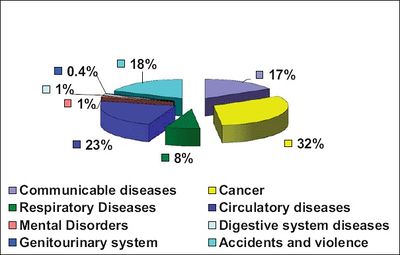Course:SPPH381B/Essays/Why is it important to study occupational health? - Zahra
Why is it important to study occupational health?
Introduction
Occupational health is defined as “a field of public health concerned with the prevention of disease, the maintenance and promotion of health among employed persons in their group setting” [1]. Through studying occupational health, one is able to gain insights into how to prevent ill-health from work-related causes. The primary argument for the importance of occupational health research is that the burden of illness and injuries associated with work is quite significant. Employers have the duty to protect workers as health and safety at work is a basic human right [2]. Therefore, an additional argument is that research is needed to provide insight on how to create safe working environments. Still, working conditions can never be perfect and thus workers must be provided with appropriate compensation. Research is needed to establish causality between work and illness or injury to provide sound evidence for compensation [3].
Burden of Disease
The International Labor Organization (ILO) and the World Health Organization (WHO), have determined that approximately 5-7% of all fatalities in industrialized countries are attributed to diseases and injuries associated with work [2]. In developing countries, this percentage is slightly smaller as non-occupational problems account for a larger proportion of total fatalities [2]. However, this is likely to change with continued rapid industrialization. Barnetson & Foster define a workplace injury as “any form of ill health –such as a physical or mental injury of illness –that arises because of a worker’s employment” [4]. When thinking about work injuries, falls, concussions and other physical acute injuries often come to mind. It is important to realize that there is much more complexity to work injuries and research into them is important because most are not the result of an obvious cause [4]. Out of all deaths due to occupational injuries and work-related diseases, 32% are attributed to work-related cancer [2]. Cancer has a long latency period. Exposure to carcinogens are likely to have occurred many years before cancer is diagnosed. Additionally, lifestyle and environmental factors can influence disease, thus making occupational connections can be difficult.

Economic Impact
Occupational health has a significant economic impact. It is estimated that 4% of global GDP is spent on the indirect and direct costs of workplace accidents and diseases [2]. There is great debate surrounding how worker’s compensation is provided and to what extent. Occupational health research is needed to reduce economic and productivity loss. It is a fundamental right that individuals work is a safe environment, however even in the best scenarios, things can go wrong and workers should be supported. It is important to establish relationships between work and ill-health as these relationships can provide the back bone for worker compensation.
Conclusion
Prevention efforts for occupational health have come a long way, but still many issues remain. Additionally, with new products come new hazards and work environments continue to change. It is important to note that the decrease in occupational injuries in developed countries is not only due to improved management and gain of knowledge, but also because of outsourcing many hazardous industries to other countries [2]. Developing countries are faced with competing social, economic, and political challenges resulting in occupational health remaining a low priority [5]. Beyond identifying the hazard, determining how it can be controlled, and ways to prevent it from forming; research surrounding the process of translating scientific evidence into policies and regulations is needed.
References
- ↑ Roberts, N. (1978). Some current challenges in occupational medicine. Journal of Occupational Medicine, 20(3): 169-172.
- ↑ 2.0 2.1 2.2 2.3 2.4 2.5 Takala, J., Hamalainen, P., Saarela, K. L., Yun, L. K., Manickam, K., Jin, T. W., Heng, P., Tjong, C., Kheng, L. G., Lim, S., & Lin. G. S. (2014). Global estimates of the burden of injury and illness at work in 2012. Journal of Occupational and Environmental Hygiene, 11: 326-337. doi: 10.1080/15459624.2013.863131
- ↑ Guidotti, T. (2013, December 12). Occupational diseases. The Canadian Encyclopedia. Retrieved from http://www.thecanadianencyclopedia.ca/en/article/occupational-diseases/
- ↑ 4.0 4.1 Barnetson, B., & Foster, J. (2016). Health and safety in Canadian workplaces. Edmonton, AB: AU Press.
- ↑ Nuwayhid, I. A. (2004). Occupational Health Research in Developing Countries: A Partner for Social Justice. American Journal of Public Health, 94(11): 1916–1921.
